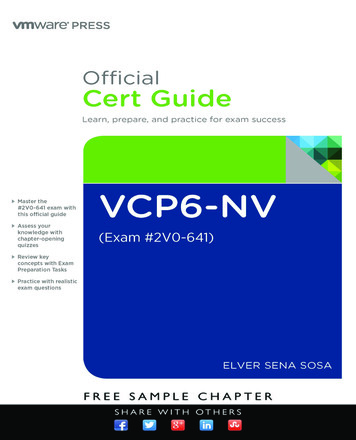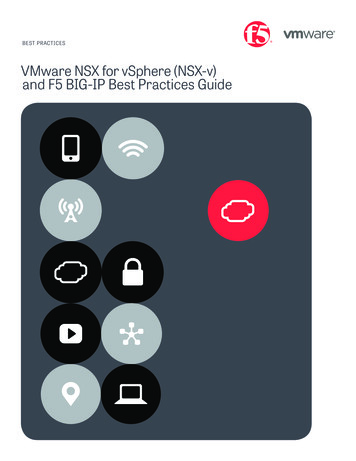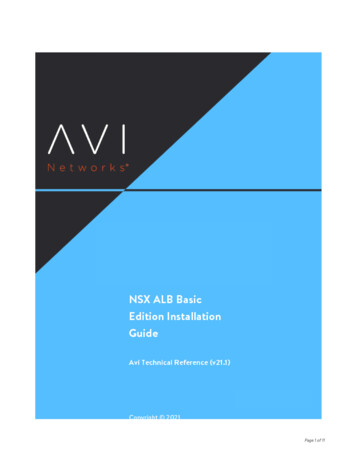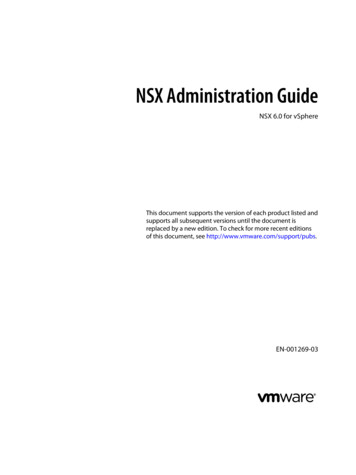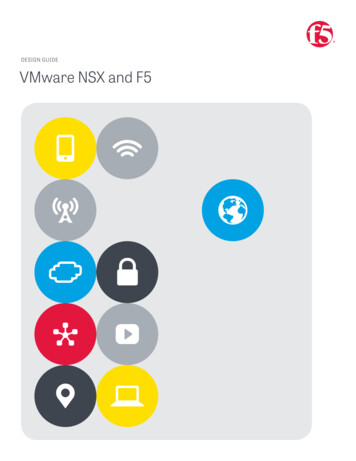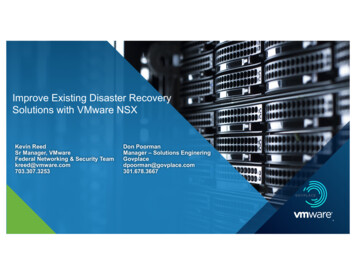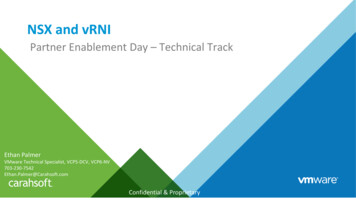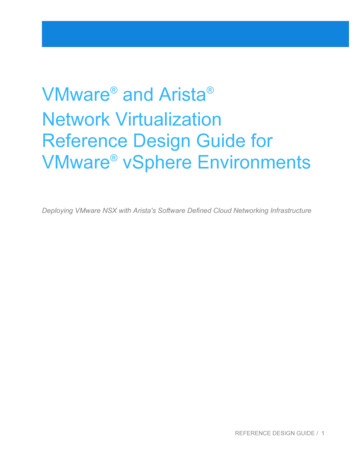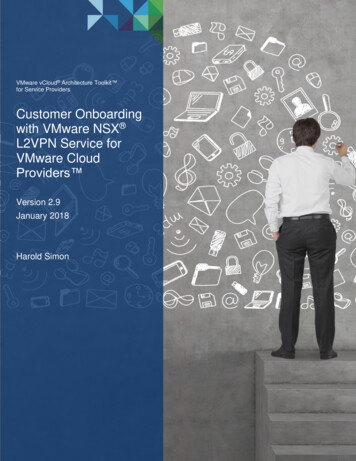
Transcription
Customer Onboarding with VMware NSX L2VPN Service for VMware vCloud NetworkVMware vCloud Architecture Toolkit for Service ProvidersCustomer Onboardingwith VMware NSX L2VPN Service forVMware CloudProviders Version 2.9January 2018Harold Simon
Customer Onboarding with VMware NSX L2VPN Service forVMware Cloud Providers 2018 VMware, Inc. All rights reserved. This product is protected by U.S. and international copyright andintellectual property laws. This product is covered by one or more patents listed re is a registered trademark or trademark of VMware, Inc. in the United States and/or otherjurisdictions. All other marks and names mentioned herein may be trademarks of their respectivecompanies.VMware, Inc.3401 Hillview AvePalo Alto, CA 94304www.vmware.com2 VMware vCloud Architecture Toolkit for Service Providers
Customer Onboarding with VMware NSX L2VPN Service forVMware Cloud ProvidersContentsIntroduction . 51.1 Overview . 51.2 Document Purpose and Scope . 51.3 Definitions, Acronyms, and Abbreviations . 6Customer Onboarding Overview . 72.1 Key Onboarding Factors . 7Conceptual Architecture . 93.1 Business Drivers . 93.2 Conceptual Architecture Solution Overview . 9Designing for VMware NSX L2VPN Service . 104.1 VMware NSX L2VPN Deployment Models . 104.2 Architecture Prerequisites . 11Management Components and Feature Design . 135.1 vSphere Component Design . 135.2 VMware NSX Component Design. 135.3 VMware NSX L2VPN Service Components. 14VMware NSX L2VPN Onboarding Scenarios . 196.2 L2VPN and New Workload Provisioning. 206.3 L2VPN with vSphere Replication . 21Conclusion . 22References . 233 VMware vCloud Architecture Toolkit for Service Providers
Customer Onboarding with VMware NSX L2VPN Service forVMware Cloud ProvidersList of TablesTable 1. VMware NSX L2VPN Server Threshold Recommendations . 18Table 2. Long-Distance vSphere vMotion Bandwidth and Latency . 20List of FiguresFigure 1. Conceptual Diagram . 9Figure 2. VMware NSX to VMware NSX Stretched L2VPN . 10Figure 3. VMware NSX to Non VMware NSX Stretched L2VPN . 11Figure 4. L2VPN Server Site Configuration . 15Figure 5. Standalone Edge Credentials . 15Figure 6. Standalone Edge Uplink Interface . 16Figure 7. Standalone Edge L2VPN Configuration . 16Figure 8. Standalone Edge Sub-Interface Configuration . 16Figure 9. L2VPN with Long-Distance vSphere vMotion Migration . 19Figure 10. L2VPN New Workload Provisioning . 20Figure 11. L2VPN with vSphere Replication . 214 VMware vCloud Architecture Toolkit for Service Providers
Customer Onboarding with VMware NSX L2VPN Service forVMware Cloud ProvidersIntroduction1.1OverviewThe VMware Cloud Provider Program is an ecosystem of over 4,000 service providers located in morethan 100 countries offering VMware based cloud services. Local providers secure data sovereignty whileproviding a wide range of cloud services and vertical market expertise through specialized complianceand certifications.VMware Cloud Providers are uniquely positioned to offer their services to the market and become aseamless extension of existing VMware enterprise customers’ on-premises data centers. Having thecapability to move workloads in and out of the customer’s chosen cloud platform is a key factor for mostenterprise customers to help them maintain their existing investments within their on-premisesapplications, and avoid lock-in to any one vendor or provider.One of the initial concerns about moving to a hybrid cloud solution is determining the methods that will beused for onboarding into a service provider infrastructure. In many cases, customers have therequirement to migrate systems with changing IP addresses or to be able to deploy new workloads to aservice provider’s infrastructure while maintaining Layer 2 connectivity with existing on-premisesworkloads.1.2Document Purpose and ScopeThis document examines some of the key prerequisites and scenarios in which VMware Cloud Providerscan leverage the VMware NSX L2VPN service to streamline the process for customers who areonboarding to a VMware Cloud Provider Program hybrid cloud solution. Where applicable, VMwareCloud Provider Program partners can enhance the customer onboarding process by offering hybridnetwork connectivity, seamless migration, and workload mobility services that help customers adopt thehosted cloud platform with less risk and impact to their running applications, and without the need forchanging IP addresses after relocating to the VMware Cloud Provider Program hosted environment. Thissolution can also be leveraged for migrations where only a portion of the workloads are being migrated,but still need Layer 2 access to other systems that remain on the customer premise.5 VMware vCloud Architecture Toolkit for Service Providers
Customer Onboarding with VMware NSX L2VPN Service forVMware Cloud Providers1.3Definitions, Acronyms, and AbbreviationsL2VPN: Layer 2 Virtual Private Network is a means of stretching logical networks across geographicallocations or sites. The connection is secured through SSL encryption.WAN: A Wide Area Network is a telecommunications network that spans a large geographical area.VXLAN: Virtual Extensible LAN is an encapsulation protocol for extending Layer 2 networks over Layer 3networks.Trunk Port: An interface on the VMware NSX Edge device or standalone NSX Edge appliance that isconfigured to carry all VLAN/VXLAN traffic.PSC: The VMware Platform Services Controller (PSC) refers to the core group of infrastructureservices that are essential to the operations of VMware vCenter . This group of services include VMwarevCenter Single Sign-On , license service, lookup service, and VMware Certificate Authority. For fulldetails of PSC deployment models and configurations, see the VMware vSphere Installation and Setupdocumentation.vCenter Single Sign-On: The service that facilitates secure authentication services to VMware vCenterServer and other software components that make up the VMware vSphere infrastructure.6 VMware vCloud Architecture Toolkit for Service Providers
Customer Onboarding with VMware NSX L2VPN Service forVMware Cloud ProvidersCustomer Onboarding OverviewThis section describes some of the concepts and criteria that are instrumental in planning for onboardingactivities. While variations of the solution can be leveraged with VMware Cloud Provider Program publiccloud offerings, the focus of this document is on the implementation of VMware NSX L2VPN for migrationto VMware Cloud Providers offering the vSphere Hosting solution.2.1Key Onboarding Factors2.1.1VMware Cloud Provider InfrastructureThe infrastructure recommended for leveraging VMware NSX L2VPN servers for migrations follows theguidelines detailed for the vSphere Hosting service. The VMware Cloud Provider will offer a managed orunmanaged instance of vSphere with VMware NSX, as well as additional product integrations formonitoring and metering of the environment.2.1.2Customer On-Premises InfrastructureSo that VMware NSX L2VPN services provide the greatest benefit, the customer will ideally have anexisting implementation of vSphere and VMware NSX for spanning VXLAN-VXLAN and VXLAN-VLAN. Ifthe customer has not yet implemented VMware NSX in their environment, the standalone NSX Edgeappliance can be deployed in the customer’s environment for the stretching of on-premises VLANs to thehosted service provider.2.1.3Hybrid Network ConnectivityThe VMware Cloud Provider must implement the necessary hybrid network connectivity between thecustomer’s on-premises data center and the VMware Cloud Provider hosted data center.The network connectivity for VMware NSX L2VPN services can be facilitated by a dedicated connectednetwork, such as an MPLS circuit or a leased-line connection, or across the Internet where VPN servicesfrom VMware NSX can be used to provide a software approach to connecting hybrid cloud data centers.See the Architecting a VMware NSX Solution for the VMware Cloud Provider Program documentprovided with the VMware vCloud Architecture Toolkit for Service Providers (vCAT-SP) for moreinformation about network connectivity.2.1.4 TenancyThis document focuses on leveraging VMware NSX L2VPN services in a VMware Cloud ProviderProgram Hosting solution as described in the introduction to the vCAT-SP located in the vCAT-SPDocumentation Center. The VMware Cloud Provider Program hosted solution is designed to be deployedper tenant. Therefore, the focus of this document is on implementation of VMware NSX L2VPN from asingle-tenant perspective.2.1.5 Users and RolesL2VPN services are used for onboarding for both managed and unmanaged implementations. Withregard to determining who will manage the onboarding activities, the VMware Cloud Provider canmanage migrations on the customer’s behalf or allow the customer to perform the migrations in a selfservice scenario. In either case, it is important to verify that the personnel have the appropriate level ofaccess to the VMware Cloud Provider Program hosted environment and the on-premises virtualenvironments to successfully perform the end-to-end task of migrating VMs to the VMware Cloud ProviderProgram hosted solution. Some details regarding onboarding options are outlined in Section 6, VMwareNSX L2VPN Onboarding Scenarios.7 VMware vCloud Architecture Toolkit for Service Providers
Customer Onboarding with VMware NSX L2VPN Service forVMware Cloud Providers2.1.5.1 Service ProviderThe service provider will offer the necessary compute, storage, and networking required for the VMwareCloud Provider Program hosted solution. Depending on the customer requirements, the service providercan manage the solution, which includes but is not limited to migration of workloads, or can provide anunmanaged service to the environment for customers who prefer the direct management of workloads inthe hosted solution.2.1.5.2 Customer/TenantThe customer or tenant will provide the compute, storage, and networking required for the on-premisesvSphere infrastructure from which workloads will be migrating.2.1.5.3 Workload Mobility and Migration ServicesThe service provider will offer a managed or self-service workload mobility service to their end customerswhere they facilitate the hybrid network connectivity and VMware Cloud Provider Program virtualinfrastructure and processes for workload mobility and migration to streamline customer onboarding.8 VMware vCloud Architecture Toolkit for Service Providers
Customer Onboarding with VMware NSX L2VPN Service forVMware Cloud ProvidersConceptual Architecture3.1Business DriversThe key business drivers for implementing this solution are to provide a simplified approach andenhanced customer onboarding (self-service or managed) between an on-premises data center and aVMware Cloud Provider while reducing the requirements for the procurement and configuration ofexternal networking hardware. With this solution, a VMware Cloud Provider can implement stretchedLayer 2 network services for their customers with low risk, speed, and agility.3.2Conceptual Architecture Solution OverviewThe following figure highlights the conceptual architecture in which the VMware Cloud Provider offersadditional services, such as replication, hybrid provisioning, workload mobility, and migration services.This architecture focuses on workload mobility and migration services.Figure 1. Conceptual Diagram9 VMware vCloud Architecture Toolkit for Service Providers
Customer Onboarding with VMware NSX L2VPN Service forVMware Cloud ProvidersDesigning for VMware NSX L2VPN Service4.1VMware NSX L2VPN Deployment ModelsWith VMware NSX L2VPN services, there are two main deployment models that the service providermust consider when offering these services to the market: Stretched L2VPN with VMware NSX on and off premises Stretched L2VPN with standalone NSX Edge on premisesThe following section provides an architecture example of both solutions.4.1.1 Stretched L2VPN with VMware NSX On PremisesIn this scenario, VMware NSX L2VPN services are configured with VMware NSX deployed both in theVMware Cloud Provider environment and in the on-premises vSphere implementation at the customer’sdata center. This scenario provides increased flexibility, because the VMware NSX L2VPN service canextend VXLAN to VXLAN, VLAN to VLAN, and VXLAN to VLAN networks between sites.In the following figure, VMware NSX is implemented on both sides of the hybrid cloud solution withseparate, non-connected instances of VMware NSX. However, for implementations that require simplifiedmanagement of long-distance VMware vSphere vMotion migrations from the on-premises site to theVMware Cloud Provider site, the vCenter Server and Platform Services Controller (PSC) instances arejoined to the vCenter Single Sign-On domain.Figure 2. VMware NSX to VMware NSX Stretched L2VPNIn the illustration, the VMware Cloud Provider (on the left) has an NSX Edge gateway applianceconfigured as the L2VPN server and the customer (on the right) has an NSX Edge gateway applianceconfigured as the L2VPN client.10 VMware vCloud Architecture Toolkit for Service Providers
Customer Onboarding with VMware NSX L2VPN Service forVMware Cloud Providers4.1.2 Stretched L2VPN with Standalone NSX EdgeWhile the VMware NSX to VMware NSX configuration offers more options, it is still possible to extendLayer 2 networks for prospective VMware Cloud Provider Program customers who have not yetimplemented VMware NSX in their on-premises infrastructure. You can enable this by deploying thestandalone NSX Edge appliance in the customer’s data center. With the standalone NSX Edge, VMwareCloud Providers can help customers extend on-premises VLANs to VXLAN-backed networks in theVMware Cloud Provider’s hosting environment.Figure 3. VMware NSX to Non VMware NSX Stretched L2VPNIn this illustration, the VMware Cloud Provide (on the left) has an NSX Edge gateway applianceconfigured as the L2VPN server and the customer (on the right) has an NSX Edge gateway applianceconfigured as the L2VPN client.This document focuses on the option with no VMware NSX on premises because VMware NSX is arelatively new product for enterprise customers.4.2Architecture PrerequisitesThis section describes the software and networking requirements for successfully implementing stretchedLayer 2 VPN with VMware NSX.4.2.1 VMware Software Product RequirementsRequired product versions detailed for this document are as follows: VMware vSphere 6.x VMware vCenter Server 6.x VMware NSX 6.2 (required for the VMware Cloud Provider) Standalone NSX Edge appliance (no VMware NSX on premises)NoteThe use of VMware vSphere Distributed Switch instances requires Enterprise Plus licensing.11 VMware vCloud Architecture Toolkit for Service Providers
Customer Onboarding with VMware NSX L2VPN Service forVMware Cloud Providers4.2.2 Networking RequirementsTo facilitate the communication between vCenter Server instances and hosts from VMware CloudProvider Program to the on-premises network, the VMware Cloud Provider and customer must determinethe means by which communication will be realized.Where applicable, VMware recommends that WAN connectivity be implemented between the customerand VMware Cloud Provider. This enables more flexibility with onboarding options that require directconnectivity for hosts between sites (for example, long-distance vSphere vMotion migration and VMwarevSphere Replication ).For situations in which WAN connectivity cannot be established, the use of public IP addresses at eachsite is required with NAT services configured for the NSX Edge and standalone NSX Edge.All networking components must be designed to meet the proper bandwidth and latency requirements forany planned site-to-site and intra-data center network traffic.12 VMware vCloud Architecture Toolkit for Service Providers
Customer Onboarding with VMware NSX L2VPN Service forVMware Cloud ProvidersManagement Components and Feature Design5.1vSphere Component DesignTo provide L2VPN services through VMware NSX between a VMware Cloud Provider and the onpremises infrastructure of the customer, vSphere must be implemented in both locations. This sectionreviews some of the key vSphere components and recommended configurations for a successfuldeployment.5.1.1 vCenter ServervCenter Server is a key component of the solution that provides centralized management of VMs in bothVMware Cloud Provider and customer locations. Additionally, it is a required component for the use ofVMware NSX with vSphere based deployments. While it is possible to have completely separatedeployments of vCenter Server with individual PSC and single sign-on (SSO) domains, deploying bothvCenter Server instances within the same SSO domain reduces some of the management tasks withinthe implementation. First, there is the benefit of having a shared view of both vCenter Server instancesprovided that the user has the required privileges for both. Additional benefits of this configuration arediscussed in Section 6, VMware NSX L2VPN Onboarding Scenarios.With the service provider model, it is common for the end customer to have their own PSC/SSO domains.Where this is the case, the long-distance vSphere vMotion operations must be performed through the APIand not through the UI with the federated view of the vCenter Server instances.5.1.2 vSphere Cluster DesignVMware recommends that clusters within the VMware Cloud Provider environment conform to theguidance established in the Architecting a VMware vSphere Compute Platform for the VMware CloudPlatform Program document. For additional NSX Edge cluster recommendations, see the Architecting aVMware NSX Solution for the VMware Cloud Provider Program document.5.1.3 Virtual SwitchesVirtual switches provide L2VPN connectivity for VMs and NSX Edge appliances. For most VMware NSXL2VPN solutions, the vSphere Distributed Switch is used. However, it is possible to use the standardvirtual switch for the configuration of the trunks ports that are used by the NSX Edge appliance. VMwarerecommends that the vSphere Distributed Switch be used for trunk port configurations because there isless management overhead during configuration of the L2VPN services at both sites. See Section 5.3.4,Trunk Port for more details about the use of trunk ports with VMware NSX L2VPN services.5.2VMware NSX Component DesignThis section discusses the key components, features, and design considerations that are instrumental tothe successful implementation of VMware NSX L2VPN services. For more details on these componentsand steps to configure VMware NSX L2VPN services, see the VMware NSX 6.2 Administration Guide.5.2.1 NSX EdgeFor this use case, the VMware Cloud Provider NSX Edge appliance acts as the L2VPN server and on thecustomer side, the standalone NSX Edge appliance acts as the client. For implementations in which themigrated workloads require Internet access, enable egress optimization on the NSX Edge fulfilling theL2VPN server role. This supports the local routing of migrated systems as opposed to sending dataacross the VPN tunnel. This allows, for example, workloads on the VMware Cloud Provider Program sideof the VPN to access the Internet locally.13 VMware vCloud Architecture Toolkit for Service Providers
Customer Onboarding with VMware NSX L2VPN Service forVMware Cloud Providers5.2.2 NSX Edge ConsiderationsFor increased availability, VMware recommends deploying the NSX Edge in a high availability (HA)configuration. In this configuration, the two NSX Edge appliances must be placed on different datastoresfor increased redundancy. The primary appliance will be active and host all NSX Edge services, while thesecondary appliance will be in standby mode. A heartbeat is maintained between the appliances over aninternal interface. For a complete description of the failover process for NSX Edge appliances deployed inHA mode, see the VMware NSX 6.2 Administration Guide.5.2.3 Standalone NSX Edge ApplianceThe standalone NSX Edge appliance is a virtual appliance that can be implemented with VMware CloudProvider Program customers that have not yet adopted VMware NSX in their on-premises data center.There is no additional charge or licensing for the standalone NSX Edge. The standalone NSX Edgeappliance is configured during deployment, and is deployed after the configuration of the L2VPN servicebecause it depends on details used during the configuration of the L2VPN server on the NSX Edge at theVMware Cloud Provider’s site.5.2.4 VMware NSX Logical SwitchWhen configuring the VMware NSX L2VPN service, logical switches will be leveraged for VMconnectivity. Logical switches used for Layer 2 network extensions communicate directly with the L2VPNserver through the trunk port interface on the NSX Edge hosting the L2VPN server service. If VXLANs arestretched from the L2VPN client, the logical switches will have a similar configuration and might beconnected to a distributed logical router (DLR) for local routing in the on-premises site.5.2.5 Transport ZonesVerify that transport zones are configured for the appropriate clusters in the VMware Cloud Providerenvironment so that the required VXLANs / logical switches are present on the desired destinationclusters.5.3VMware NSX L2VPN Service Components5.3.1 L2VPN ServerThe L2VPN server will be configured on the NSX Edge appliance hosted on the VMware Cloud Providerside of the solution. The L2VPN server contains the important details regarding the configuration ofnetworks that are being extended. Configuration of the L2VPN server is typically facilitated by theVMware Cloud Provider but might require customer input for configuration details.5.3.2 L2VPN Server Global ConfigurationThis section of the configuration contains details such as the external interface IP address, port number,and encryption algorithm that will be used for L2VPN client connections.5.3.2.1 L2VPN Server Site ConfigurationThis section of the L2VPN server configuration page contains details, such as the connection name, userID and password, the sub-interface that will be extended, egress optimization IP addresses, andspecification of non-stretched networks.14 VMware vCloud Architecture Toolkit for Service Providers
Customer Onboarding with VMware NSX L2VPN Service forVMware Cloud ProvidersFigure 4. L2VPN Server Site Configuration5.3.3 L2VPN ClientThe L2VPN client will be configured on the NSX Edge or standalone NSX Edge that is deployed on theremote (customer) side of the solution. After the L2VPN service is configured on the VMware CloudProvider Program side, the provider will inform the customer of the details that will be required for thesuccessful pairing of the L2VPN client with the L2VPN server.NoteThe configuration details of the standalone NSX Edge are entered during the deployment of thestandalone NSX Edge appliance OVF file in vCenter Server. See the following figures for viewsrelated to the standalone NSX Edge L2VPN client menu.Figure 5. Standalone Edge Credentials15 VMware vCloud Architecture Toolkit for Service Providers
Customer Onboarding with VMware NSX L2VPN Service forVMware Cloud ProvidersFigure 6. Standalone Edge Uplink InterfaceFigure 7. Standalone Edge L2VPN ConfigurationFigure 8. Standalone Edge Sub-Interface Configuration16 VMware vCloud Architecture Toolkit for Service Providers
Customer Onboarding with VMware NSX L2VPN Service forVMware Cloud Providers5.3.4 Trunk PortBoth the NSX Edge and the standalone NSX Edge appliance require the configuration of a trunk portinterface. This interface is used to connect the NSX Edge appliances to the local VLANs or VXLANs thatwill be stretched between the on-premises data center and the VMware Cloud Provider. Some of thedesign considerations to consider with the trunk port configuration on the NSX Edge are as follows: Port group security – The port group configured for trunk port usage requires one of the followingconfigurations:oVLAN setting of VLAN trunk, with the specified VLANs configuredoPromiscuous mode and forged transmitsNoteWhen configuring the NSX Edge appliance, port group security settings are configuredautomatically by VMware NSX.Considerations when configuring the trunk port configuration for the standalone NSX Edge appliance areas follows: Port group security – The port group configured for trunk port usage requires one of the followingconfigurations:oVLAN setting of VLAN trunk, with the specified VLANs configuredoSink port configuration (recommended) or promiscuous mode enabledoForged transmitsFor full details on the configuration of trunk ports for VMware NSX L2VPN services, see the VMware NSXAdministration Guide. Also, see the Layer 2 VPN to the Cloud blog post for additional configuration detailsfor the VMware NSX L2VPN service.5.3.5 Tunnel IDThe Tunnel ID is a construct that is used to map/associate the networks between sites. In Figure 2 andFigure 3, the Tunnel ID 1203 maps the VXLAN 6002 on the L2VPN server side (VMware Cloud Provider)of the VPN tunnel to VLAN 203 on the L2VPN client side (customer) of the VPN tunnel.5.3.6 Egress OptimizationFor implementations that require workloads on the extended segment located within the VMware CloudProvider to access the Internet, egress optimization can be enabled on the NSX Edge appliances with anegress optimization IP address. Typically, this is the same IP address as the default gateway that is usedfor the on-premises network being extended to the VMware Cloud Provider. Enabling this feature allowsInternet bound traffic on the provider side of the connection to exit (egress) through the local egressoptimization gateway instead of sending the traffic back over the extended network link to the Internet andthen back across the extended link.The egress optimization feature is intended to be used to allow extended workloads to access the Internetor other networks within the VMware Cloud Provider’s environment.17 VMware vCloud Architecture Toolkit for Service Providers
Customer Onboarding with VMware NSX L2VPN Service forVMware Cloud Providers5.3.7 VMware NSX L2VPN Service Threshold RecommendationsThis section provides configuration threshold recommendations to consider when using the VMware NSXL2VPN service. These are guidelines to provide optimal user experience and reliability of the underlyingservice.Table 1. VMware NSX L2VPN Server Threshold RecommendationsDescriptionRecommend ThresholdNumber of L2VPN clients per L2VPN server5Number of networks per L2VPN server and L2VPN client pair20018 VMware vCloud Architecture Toolkit for Service Providers
Customer Onboarding with VMware NSX L2VPN Service forVMware Cloud ProvidersVMware NSX L2VPN Onboarding ScenariosCustomer onboarding can encompass several scenarios. Some common onboarding scenarios includethe following: Migration of live workloads Offline data transfer of workloads Provisioning of new workloadsThis section describes some of the scenarios in which the VMware NSX L2VPN service can be leveragedas a means for onboarding customer workloads to a VMware Cloud Provider.Long-distance vSphere vMotion migration is an attractive feature to leverage when considering VMwareNSX L2V
to VMware Cloud Providers offering the vSphere Hosting solution. 2.1 Key Onboarding Factors 2.1.1 VMware Cloud Provider Infrastructure The infrastructure recommended for leveraging VMware NSX L2VPN servers for migrations follows the guidelines detailed for the vSphere Hosting service. The VMware Cloud Provider will offer a managed or

